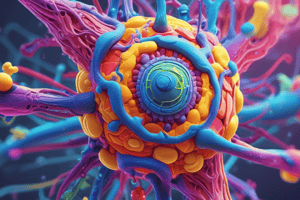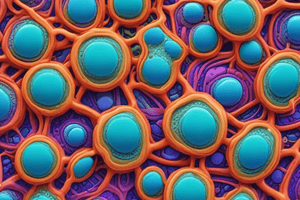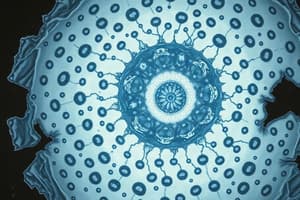Podcast
Questions and Answers
Which cellular component is primarily responsible for detoxification within the cell?
Which cellular component is primarily responsible for detoxification within the cell?
- Golgi Body
- Smooth Endoplasmic Reticulum (correct)
- Mitochondrion
- Ribosome
What is the primary function of the Golgi body within a cell?
What is the primary function of the Golgi body within a cell?
- Generating energy through cellular respiration
- Storing genetic material
- Processing and packaging proteins and lipids (correct)
- Synthesizing proteins
What is the critical function of the nuclear membrane?
What is the critical function of the nuclear membrane?
- To surround the nucleus of the cell
- To control cell activities such as growth
- To control the entry and exit of substances into and out of the nucleus (correct)
- To provide energy for cell activities
Which of the following describes the function of a partially permeable cell membrane?
Which of the following describes the function of a partially permeable cell membrane?
Which organelle within a cell is primarily responsible for aerobic respiration, thus providing energy for cellular activities?
Which organelle within a cell is primarily responsible for aerobic respiration, thus providing energy for cellular activities?
What is the main significance of the differentiation process in cells?
What is the main significance of the differentiation process in cells?
What is stored in the fluid-filled space in plant cells?
What is stored in the fluid-filled space in plant cells?
What structural characteristic differentiates a red blood cell?
What structural characteristic differentiates a red blood cell?
Which of the following is a key adaptation of red blood cells that directly enhances oxygen transport?
Which of the following is a key adaptation of red blood cells that directly enhances oxygen transport?
What is the primary role of the numerous mitochondria in muscle cells?
What is the primary role of the numerous mitochondria in muscle cells?
Why is a lower water potential in the cell sap of root hair cells crucial for water absorption?
Why is a lower water potential in the cell sap of root hair cells crucial for water absorption?
What is the purpose of the elongated and cylindrical shape of muscle cells?
What is the purpose of the elongated and cylindrical shape of muscle cells?
How does the uniformly thin cell wall of root hair cells aid in the absorption of water and ions?
How does the uniformly thin cell wall of root hair cells aid in the absorption of water and ions?
Which of the following best describes the function of ribosomes?
Which of the following best describes the function of ribosomes?
What directly facilitates the transport of proteins from the RER (rough endoplasmic reticulum) to the Golgi apparatus?
What directly facilitates the transport of proteins from the RER (rough endoplasmic reticulum) to the Golgi apparatus?
During protein transport and secretion, where does the chemical modification and packaging of proteins primarily occur?
During protein transport and secretion, where does the chemical modification and packaging of proteins primarily occur?
Flashcards
Surface Area to Volume ratio
Surface Area to Volume ratio
Increased ratio enhances O2 uptake and transport efficiency.
Importance of the nucleus absence
Importance of the nucleus absence
Lack of nucleus allows more hemoglobin packing for O2 transport.
Flexible cell surface membrane
Flexible cell surface membrane
Enables cells to change shape and pass through capillaries easily.
Muscle cell characteristics
Muscle cell characteristics
Signup and view all the flashcards
Root hair cell function
Root hair cell function
Signup and view all the flashcards
Role of mitochondria in cells
Role of mitochondria in cells
Signup and view all the flashcards
Ribosome function in protein synthesis
Ribosome function in protein synthesis
Signup and view all the flashcards
Protein transporting process
Protein transporting process
Signup and view all the flashcards
Cell
Cell
Signup and view all the flashcards
Nucleus
Nucleus
Signup and view all the flashcards
Cytoplasm
Cytoplasm
Signup and view all the flashcards
Cell Membrane
Cell Membrane
Signup and view all the flashcards
Mitochondrion
Mitochondrion
Signup and view all the flashcards
Chloroplast
Chloroplast
Signup and view all the flashcards
Vacuole
Vacuole
Signup and view all the flashcards
Specialized Cells
Specialized Cells
Signup and view all the flashcards
Study Notes
Cells
- Basic unit of life
- Takes raw materials and processes them to make new molecules
Microscopes
- Light microscope: magnifies 1000x
- Electron microscope: magnifies 200,000x
- Light micrographs can be artificially colored
Parts of a Cell
- Protoplasm: living material; includes nucleus and cytoplasm
- Nucleus: surrounded by a membrane
- Contains genetic material for cell division
- Controls cell activities (growth, repair)
- Important for cell division
- Cytoplasm: jelly-like substance with organelles
- Each organelle has a specific function
- Site of cellular activities
- Cell membrane: partially permeable membrane
- Made of lipids and proteins
- Controls substances entering/leaving the cell
- Cell wall (plant cells only): outermost part
- Made of cellulose
- Fully permeable to small molecules
Animal Cell
- Surrounded by cell membrane
- Contains nucleus, cytoplasm, mitochondrion, ribosome, vacuole, endoplasmic reticulum
Plant Cell
- Surrounded by a cell wall, cell membrane
- Contains nucleus, cytoplasm, mitochondrion, ribosome, chloroplasts, vacuole, endoplasmic reticulum
Nucleus
- Separates the contents of the nucleus from the cytoplasm
- Stores hereditary information for cell division
- Made of proteins and DNA
- Chromatin condenses to form chromosomes
Cytoplasm
- Jelly-like substance with embedded organelles
- Where cellular activities occur
Cell Membrane
- Partially permeable, allowing some things in and out
- Made of lipids and proteins
- Controls what enters and leaves the cell
Cell Wall (Plants)
- Outermost layer of the cell
- Made of cellulose
- Provides support and protection
Vacuole
- Fluid-filled space
- Large and central in plant cells (cell sap)
- Small and numerous in animal cells (water, food)
Mitochondria
- Small, oval-shaped
- Enclosed by a double membrane (inner is folded)
- Site of aerobic respiration
- Provides energy for cell activities
Chloroplasts (Plant cells)
- Oval-shaped
- Contains chlorophyll (essential for photosynthesis)
- Site of photosynthesis
Ribosomes
- Makes proteins
- Located in cytoplasm, or on endoplasmic reticulum
Endoplasmic Reticulum (ER)
- Network of flattened sacs
- Smooth ER: synthesizes lipids, detoxifies substances
- Rough ER: synthesizes proteins and has ribosomes attached
Golgi Apparatus
- Stack of flattened sacs surrounded by membranes
- Processes, packages, and stores proteins/lipids made in ER
Specialized Cells
- Cells adapted in specific ways to perform specific tasks
- Red blood cells: no nucleus, contain hemoglobin; for O2 transport
- Muscle cells: elongated, cylindrical; containing contractile proteins for movement
Protein Transporting
- Ribosomes make proteins
- Proteins go to the endoplasmic reticulum for transporting
- Vesicles transport proteins to golgi
- Golgi modifies, packages, and sorts
- Secretory vesicles carry proteins out of the cell
Studying That Suits You
Use AI to generate personalized quizzes and flashcards to suit your learning preferences.




